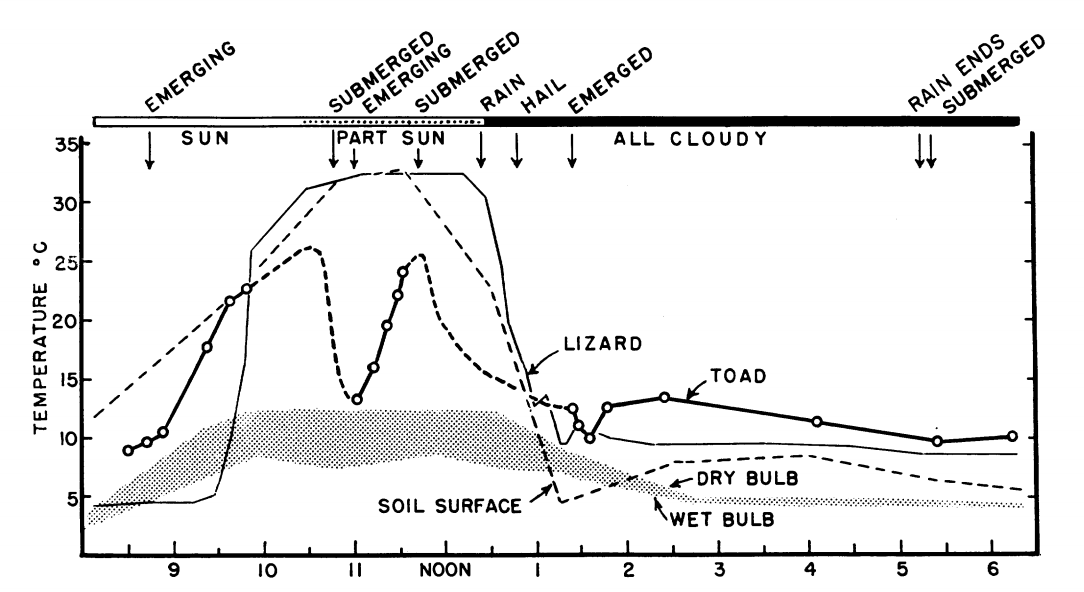10.5 Summary
In this module, we have reviewed some of the historical developments in the study of animal thermoregulation. Besides trying to relate the discussion to other ecological areas, especially foraging, I have endeavored to point where a quantitative knowledge of the heat transfer processes has helped to clarify the adaptive significance of animal morphology, behavior and physiology. Bakken and Gates (1975), Campbell (1977) and others (see Bakken 1979a for review) have developed the operative environmental temperature as a way to summarize how the organism “feels” the thermal environment. This concept has had useful applications in both physiology and ecology.
Table 10.2. A small shrub 0.5 m high provided broken shade for cylinder 8. All cylinders were in an area of \(1 \times 2 m\). Microclimate parameters for this area were as follows: \(T_{air}=26^{\circ}C\), \(T_{ground}=38.5^{\circ}C\); wind at 20 cm=\(67 cm s^{-1}\); wind at 90 cm=\(310 cm s^{-1}\); solar radiation in an 0.3- to 3-\(\mu\) band=\(1.3 cal \;cm^{-2} min^{-1}\). August 17, 1972, 14:15 to 14:16. Douglas Lake, Cheboygan County, Michigan. (From Bakken, G.A. and D.M. Gates 1975, p. 265.)
| Cylinder | Diameter (cm) | Position | Exposure | Height (cm) | Color | T (°C) |
|---|---|---|---|---|---|---|
| 1 | 1.6 | ESE-WNW | Sun | 0.3 | White | 37.5 |
| 2 | 1.6 | ESE-WNW | Sun | 0.3 | Black | 50 |
| 3 | 1.6 | ESE-WNW | Sun | 0.3 | Gray | 45.5 |
| 4 | 1.6 | NNE-SSW | Sun | 0.3 | Gray | 46 |
| 5 | 1.6 | Vertical | Sun | 0.3 | Gray | 41 |
| 6 | 1.6 | ESE-WNW | Sun | 20 | Gray | 39.5 |
| 7 | 1.6 | ESE-WNW | Sun | 90 | Gray | 36 |
| 8 | 1.6 | ESE-WNW | Shade | 1 | Gray | 28.3 |
| 9 | 0.64 | ESE-WNW | Sun | 0.3 | Gray | 41.5 |
| 10 | 1.6 | ESE-WNW | Sun | 0.3 | Gray | 45.5 |
| 11 | 2.86 | ESE-WNW | Sun | 0.3 | Gray | 45.5 |
| 12 | 3.81 | ESE-WNW | Sun | 0.3 | Gray | 47.5 |
| 13 | 15.5 | ESE-WNW | Sun | 1 | Gray | 47 |

Figure 10.10: Body temperature of a telemetered free-ranging Bufo spinulosus compared with that of a telemetered free-ranging Liolaemus multiformis at the same time. 22 March; 4,300 m. Temperature of soil surface was measured at a spot exposed to the sun. Comments at top of the figure referring to submergence and emergence pertain to the toad. (From Pearson, O.P. and Bradford, D.F. 1976, p. 165).